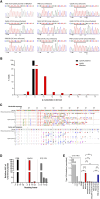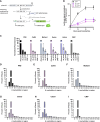Understanding off-target growth defects introduced to influenza A virus by synonymous recoding
- PMID: 40796271
- PMCID: PMC12530121
- DOI: 10.1261/rna.080675.125
Understanding off-target growth defects introduced to influenza A virus by synonymous recoding
Abstract
CpG dinucleotides are underrepresented in the genomes of most RNA viruses. Synonymously increasing CpG content of a range of RNA virus genomes reliably causes replication defects due to the recognition of CpG motifs in RNA by cellular zinc-finger antiviral protein (ZAP). Prior to the discovery of ZAP as a CpG sensor, we described an engineered influenza A virus (IAV) enriched for CpGs in segment 5 that displays the expected replication defects. However, we report here that this CpG-high ("CpGH") mutant is not attenuated by ZAP. Instead, a pair of compensatory nucleotide changes, resulting in a stretch of eight consecutive adenosines (8A), were found to be responsible. Viral polymerase slippage occurs at this site, resulting in the production of aberrant peptides and type I interferon induction. When the nucleotides in either one of these two positions were restored to wild-type sequence, no viral attenuation was seen, despite the 86 extra CpGs encoded by this virus. Introduction of these two adenosines into wild-type virus (thereby introducing the 8A tract) resulted in viral attenuation, polymerase slippage, aberrant peptide production and type I interferon induction. That a single nucleotide change can offset the growth defects in a virus designed to have a formidable barrier to wild-type reversion highlights the importance of understanding the processes underlying viral attenuation. Poly(A) tracts are a correlate for the emergence of polybasic cleavage sites in avian IAV hemagglutinins to produce highly pathogenic strains. These results thereby uncover possible insights into the intermediary events of this important evolutionary process.
Keywords: RNA polymerase; frameshift; influenza virus; synonymous recoding.
© 2025 Sharp et al.; Published by Cold Spring Harbor Laboratory Press for the RNA Society.
Figures









References
-
- Atkinson N, Witteveldt J, Evans D, Simmonds P. 2014. The influence of CpG and UpA dinucleotide frequencies on RNA virus replication and characterization of the innate cellular pathways underlying virus attenuation and enhanced replication. Nucleic Acids Res 42: 4527–4545. 10.1093/nar/gku075 - DOI - PMC - PubMed
MeSH terms
Substances
Grants and funding
LinkOut - more resources
Full Text Sources
